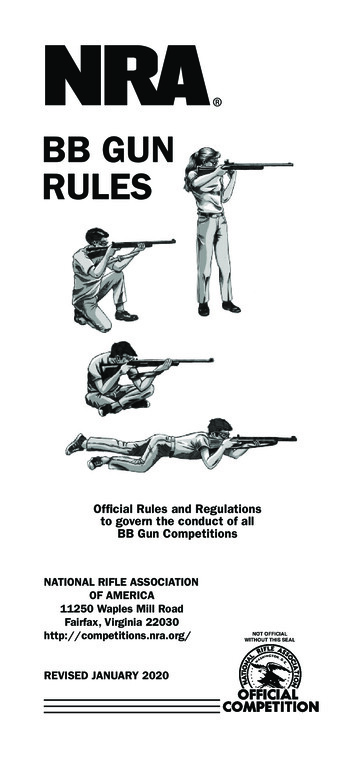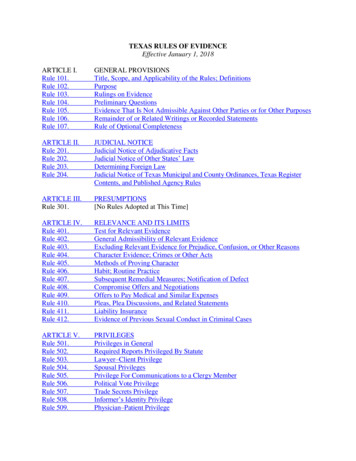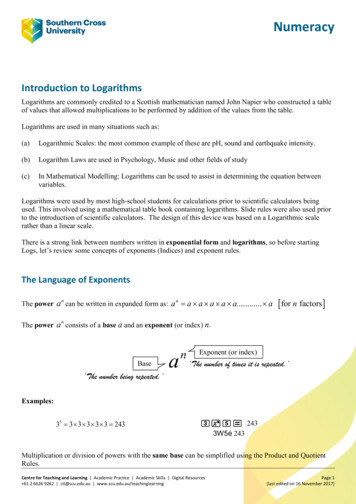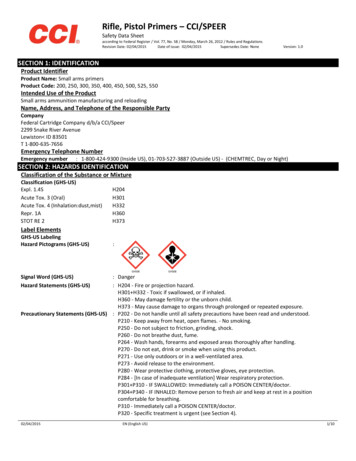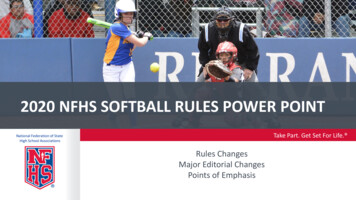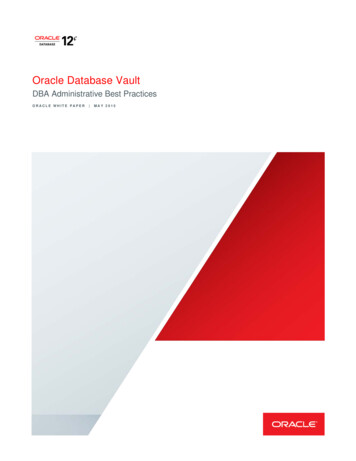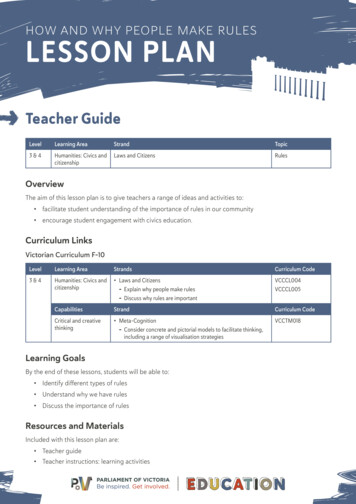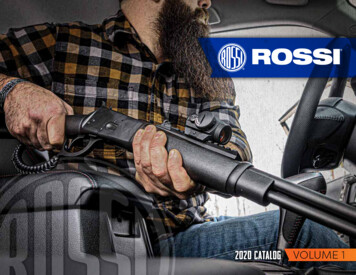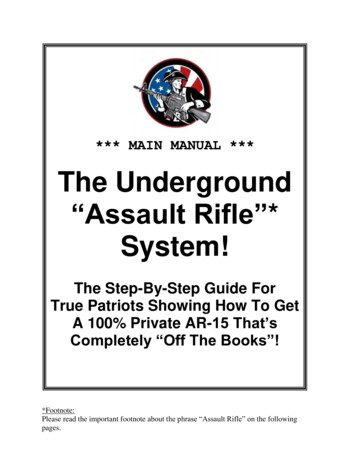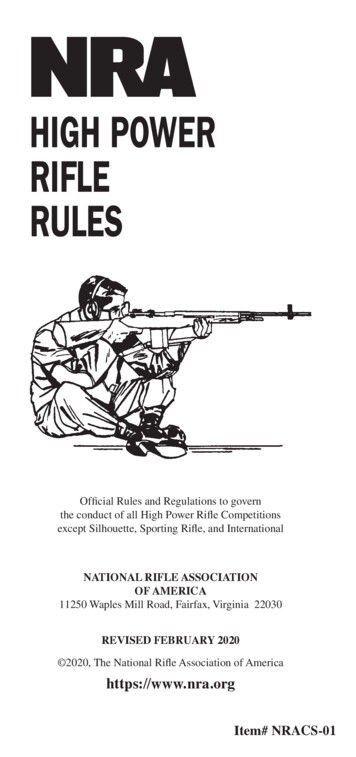
Transcription
HIGH POWERRIFLERULESOfficial Rules and Regulations to governthe conduct of all High Power Rifle Competitionsexcept Silhouette, Sporting Rifle, and InternationalNATIONAL RIFLE ASSOCIATIONOF AMERICA11250 Waples Mill Road, Fairfax, Virginia 22030REVISED FEBRUARY 2020 2020, The National Rifle Association of Americahttps://www.nra.orgItem# NRACS-01
CONTENTSNRA HIGH POWER RIFLE RULESApproved and Registered Tournaments. iiiSec. 1.NRA Competitions. 1Sec. 2.Eligibility of Categories of Competitors. 4Sec. 3.Equipment and Ammunition. 7Sec. 4.Targets. 13Sec. 5.Positions. 15Sec. 6.Range Standards.17Sec. 7.Courses of Fire.18Sec. 8.Time Limits.22Sec. 9.Competition Regulations.23Sec. 10. Range Commands,Control and Operations.27Sec. 11. Tournament Officials.39Sec. 12. Team Officers’ Duties and Position.43Sec. 13. Physically Disabled Shooters.44Sec. 14. Scoring and Marking.45Sec. 15. Decision of Ties.52Sec. 16. Challenges and Protests.53Sec. 17. National Records.55Sec. 18. Competitor’s Duties and Responsibilities.59Sec. 19. National High Power Rifle Classification.61Sec. 20. NRA Official Referee.64Sec. 21. NRA Competition Programs.66Sec. 22. F-Class Rifle Rules.68Sec. 23 Mid-Range (Prone) Tactical Rifle (AR).74Sec. 24 300 Meters.76Appendix General Regulations for NRASanctioned Tournaments.81Glossary .86Addendum.87Honorary Clubs.88Coaches Medal.89NRA Distinguished Badge.90Index.92ii 2020 NRA HIGH POWER RIFLE RULEBOOK
APPROVED AND REGISTERED TOURNAMENTSApplication forms for both types of sanctioned tournaments may beobtained from the NRA. Official application for approval to conduct an NRA Approved or Registered Tournament must be made to the Competitions Division. Thedeadline, in advance of firing date for receipt of the completed application formsand programs, is 30 days for Approved, and 45 days for Registered Tournaments.In order to be listed once in the Coming Events section of Shooting Sports USA(monthly), dates must be received and sanctioned by NRA by at least 75 days priorto the month of issue. (See General Regulations for Shooting Sports USA deadlines).A Registered Tournament is the more formal of the 2 types. Differences betweenthe 2 types of competitive tournaments are:Scores used forclassificationScores used forNational A registration feeper competitor(remitted after thetournament is fired).This is explained insponsor’s packetYesYesA7, B7Competitors must beNRA membersNoNoGen’lReg.1.6(f)Minimum number ofshots requiredNoYesGen’l Reg.Reg. A5, B5NRA classificationor category systemmust be usedOptionalYesGen’lReg. A4, B4NRA Membership Number is required for classification purposes in all NRASanctioned Tournaments. Should a competitor not be an NRA member, he will beassigned a special number that allows his scores to be entered into the computer.Fixed awardscheduleNoYesTournament officialscompetingOnlysupervisorcannotcompeteOnly theMatch Director,Chief StatisticalOfficer and OfficialReferee may notcompete.Official Refereeassigned by NRANo,Yes, with theSponsorexception thatselectsa 3- member jurySupervisorwill be assignedby the TournamentSponsor fortournamentsbelow the StateChampionship level.Sponsor required tofurnish eachcompetitor withOfficial BulletinNoYesGen’lReg. A6, B611 & Gen’lReg. A8,B811.2.1Gen’lReg. B12Program preparedand distributed by21 & Gen’lSponsorYesYesReg. A2,B22020 NRA HIGH POWER RIFLE RULEBOOK iii
NOTESiv 2020 NRA HIGH POWER RIFLE RULEBOOK
NATIONAL RIFLE ASSOCIATIONOfficial Rules for High Power Rifle MatchesThese rules establish uniform standards for NRA sanctioned high powerrifle competition. Where alternatives are shown, the least restrictive conditions apply unless the tournament program sets forth limitations. The rules donot apply to High Power Sporting Rifle, Silhouette or International ShootingUnion type competition. They supersede all earlier editions and remain ineffect until specifically superseded.Tournament sponsors may not alter these rules. If sponsors require additional rules for special conditions, the additions must be fully set forth inthe program for the competition concerned.The arrangement and rule numbering systems are such that correspondingrules for other types of NRA competition are correspondingly located andnumbered in the Rule Books for those competitions. Gaps in the sequence ofrule numbers result from there being a rule in one or more of the other RuleBooks that does not apply in this book.Recommendations for rule changes may be forwarded to the High PowerRifle Committee in care of the National Rifle Association.NOTE: Rules in which major changes have bee made since publication ofthe previous Rule Book are marked thus: (1.1).1. NRA COMPETITION1.0 NRA Competition— Competition that is authorized in advance offiring by the National Rifle Association. The program, range facilities andofficials must comply with standards established by the NRA. The types oftournaments which are Sanctioned are listed in Rule 1.6.1.1 Sanctioned Tournament—A series of matches covered by an OfficialProgram. Such matches may be all individual matches, all team matches, ora combination of both. They may be all fired matches or a combination offired and aggregate matches. A tournament may be conducted on one day,or successive days, or may provide for intervening days between portionsof the tournament, such as tournaments programmed to be conducted overmore than one weekend.1.2 Authorization—Before a match is publicized in programs or otherwise, the sponsoring organization of each type of competition mentioned inRule 1.6 shall have agreed to comply with the current regulations for suchcompetition and shall have received notice from the NRA that the competition has been authorized.1.3 Rules—The local sponsor of each type of competition must agree toconduct the authorized competition according to NRA Rules, except as theseRules have been modified by the NRA in the General Regulations for thattype of competition.1.4 General Regulations—The local sponsor of each type of competitionmust agree to comply with the General Regulations published by the NRA forthe competition concerned. See Appendix in back of this rule book.1.5 Refusal or Withdrawal of NRA Authorization—The NRA mayrefuse to authorize or may withdraw its authorization for any competitionthat cannot, or does not, comply with the requirements for that competition.1.6 Types of Tournaments—The types of tournaments listed below arethose that are Sanctioned by NRA in its competitive shooting program.(a)International Matches—Arranged by the NRA with the recognizednational shooting organization(s) of the countries concerned. Theofficials of the tryouts are appointed by the NRA.2020 NRA HIGH POWER RIFLE RULEBOOK 1
(b) International Team Tryouts—U.S. tournaments conducted underNRA Rules organized or authorized by the NRA as preliminary orfinal tryouts for the selection of International Team members. Theofficials of the tryouts are appointed by the NRA.(c)National Championships—Organized by the NRA, and in some casesin conjunction with the Corporation for the Promotion of Rifle Practiceand Firearms Safety, to form the National Matches. The officials ofthe matches are appointed by the NRA. These tournaments will beRegistered.(d) Regional and Sectional Championships—Arranged between theNRA and a local sponsoring organization. These tournaments willbe Registered.(e)State Championships—Annual tournaments authorized and/or conducted by State Rifle and/or Pistol Associations, affiliated with theNRA. Such State Associations may if desired, authorize local organizations to sponsor and conduct State Championships. In states wherethere is no NRA affiliated State Association, the NRA may authorizea local organization to sponsor and conduct the State Championship.State Championships will be Registered Tournaments.(f)Registered Tournaments—May be authorized by the NRA after application has been filed by the sponsoring organization. Applicationforms are available from NRA on request. National Records mayonly be established in Registered Tournaments (Rule 17.1).(g) Approved Tournaments—May be authorized by the NRA after application has been filed by the local organization that will act as thesponsor. Application forms are available from NRA on request.(h) Sanctioned Leagues (shoulder-to-shoulder or postal)—May beauthorized by the NRA after application has been filed by a localgroup or organization. Application forms are available from NRAon request. Sanctioned League scores are used for classification. ALeague need not be operated by an Affiliated Club or Organization.(i)Postal Matches—Organized by the NRA and publicized to groupsconcerned through the Shooting Sports USA, announcements and/orspecial mailings.(j)Special Tournaments—May be sanctioned by NRA for types ofshooting not otherwise a part of the NRA program.(k) State and Senior Games—Tournaments that are part of the State andSenior Game program. Such tournaments are not charged fees, nor willany scores fired be used for classification. A simplified sanctioningprocedure may be used, and these events will be listed in ComingEvents section of Shooting Sports USA with the only contact beingthe State Coordinator.1.7 Types of matches—(a)Match—A complete event as indicated in the program for the awardingof certain specific prizes. A match may consist of one or of severalstages. It may, in the case of aggregate matches, include the scoresfired in several subsidiary matches.(b) Stage—A portion of a match that consists of one or more stringsfired in one position, distance, time allowance (slow or rapid fire,for example), or target.(c)Open Match—A match open to anyone, except that if so stated inthe program an open match may be limited to one or any combination of the following: (a) United States citizens; (b) members of theNational Rifle Association of America; and/or (c) with respect tonon-U.S. citizens, (d) persons who are members in good standing oftheir respective National Shooting Federations or Associations.2 2020 NRA HIGH POWER RIFLE RULEBOOK
(d) Restricted Match—A match in which competition is limited to specified groups, i.e., juniors, women, police, civilians, veterans, etc.; or tospecified classes, i.e., High Masters, Masters, Experts, Sharpshooters,Marksmen, etc.(e)Classified Match—A match in which awards are given to the winners and to the highest competitors in several specified classes suchas High Masters, Masters, Experts, Sharpshooters, Marksmen. Theclassification of competitors may be accomplished by the NationalClassification System (Sec. 19) or by other means. The program forclassified matches must specify the groups or classes in which awardswill be made.(f)Invitational Match—A match in which participation is limited tothose who have been invited to compete.(g) Squadded Individual Match—A match in which each competitor isassigned a definite relay and target by the Statistical Office. Failureto report on the proper relay or firing point forfeits the right to fire.All entries must be made before firing commences in that match,except when otherwise stated in the tournament program.(h) Unsquadded Individual Match—A match in which the competitoris not assigned a definite relay or target by the Statistical Office.The competitor reports to the Range Officer within the time limitsspecified in the program and is then assigned to a target and a relayin which to fire.(i)Re-Entry Match—A match in which the competitor is permitted tofire more than one score for record; one or more of the highest scoresdetermine the relative rank of competitors. The number of scoresthat may be fired, and the number of high scores to be consideredin deciding the relative rank of competitors must be specified in theprogram. Scores fired in these matches shall not be used for classification purposes.(j)Squadded Team Match—A match in which the teams are assigneda definite time to fire. Teams may be assigned one or more adjacenttargets. All entries must be made before firing commences in thatmatch. The entire team must report and fire as a unit.(k) Unsquadded Team Match—A match in which the teams may report tothe firing line at any time within the limits specified in the program,targets being assigned by the Range Officer. The entire team mustreport and fire as a unit, unless the program provides otherwise.(l) Aggregate Match—A match of the scores from two or more matches.This may be an aggregate of match stages, individual matches, teammatches, or any combination, provided the tournament programclearly states the matches that will comprise the aggregate. Entries inaggregate matches must be made before the competitor commencesfiring in any of the matches making up the aggregate match.PUBLIC AFFAIRSAll tournament sponsors are urged to give special consideration to theneeds of news media personnel in order to achieve maximum publicityfor the competition. Public news media personnel representing printand/or broadcast should be given every consideration and cooperationin keeping with the proper conduct and safety of the competition.2020 NRA HIGH POWER RIFLE RULEBOOK 3
2. ELIGIBILITY AND CATEGORIESOF COMPETITORSEligibility and Categories of Competitors. The conditions of a matchshall prescribe the eligibility and categories of competitors, team or individuals, in accordance with Rule 1.6 and/or the definitions contained in Section 2.Any limitations of eligibility to compete must be stated in the Match Program.INDIVIDUALS2.1 Members of the National Rifle Association—Any individual member,including Benefactors, Patrons, Endowment, Life, Annual, Associate, NonResident and Junior members.2.1.1 Non- U.S. Citizens—Non- U.S. Citizens may compete and areeligible to win any NRA Sanctioned Tournament, unless further restrictionsare imposed by conditions stated in the program.2.1.2 Categories and Special Awards—If there are a sufficient number ofcompetitors of a specific group (i.e., Women, Juniors, Service, etc.), a matchsponsor may, at his discretion, establish a separate category for this groupand make classification awards within this category, such as 1st Master Service, 3rd Sharpshooter Civilian, and so on. However, if there are insufficiententries of a specific group to warrant such a separation, and if the sponsorstill wishes to provide recognition to this specific group, he may provide anoverall Special Award such as High Woman, High Junior, etc., and all competitors in this specific group would be eligible for this one Special Award.Details concerning categories and special awards must be clearly outlined inthe tournament program.2.2 Civilian—Any civilian including all members of the Reserve OfficersTraining Corps (ROTC, NROTC and AFROTC), personnel of the State Security Forces (e.g., State Guard organizations having no federal recognition),retired members of each of the several services comprising the Armed Forcesof the United States, and members and former members entitled to receivepay, retirement pay, retainer pay or equivalent pay, are classified as civiliansexcept as noted in the example below. All competitors who are enrolled undergraduates of any of the service academies will be considered as civiliansand may compete in collegiate and ROTC categories.Individuals of any Reserve or National Guard component who, during thepresent calendar year, have not competed as National Guard (2.5) or RegularService (2.6) or Reserve component (2.7) and have not been provided Servicesupport for competition (in the form of firearms, ammunition, payment of travelor other expenses), wholly or in part, may fire as civilians. The provision offirearms and ammunition for a specific competition (i.e., National Matches orRegional Leg Matches), when such is available to both military and civiliancompetitors, is not considered Service support under this Rule.Unless specifically authorized to do so by the tournament program, membersof the regular Army, Navy, Air Force, Marine Corps, Coast Guard, membersof the Reserve components on active duty, retired personnel of the severalservices comprising the Armed Forces of the United States on active duty, orpolice (2.4) are not permitted to compete as civilians.2.2.1 Senior—A person may compete as a Senior beginning on January 1,of the calendar year in which his or her 60th birthday occurs.2.2.2 Grand Senior - A person may compete as a Grand Senior beginningon January 1 of the calendar year in which his or her 70th birthday occurs.2.3 Junior—A person may compete as a Junior through December 31,of the calendar year in which the twentieth birthday occurs. Individuals whohave National Guard, Reserve or active duty status and receive support (asdefined in Rule 2.2) may not compete as juniors.2.3.1 Intermediate Junior—A Junior may also compete as an IntermediateJunior from January 1 of the calendar year in which his or her 15th birthday4 2020 NRA HIGH POWER RIFLE RULEBOOK
occurs through December 31 of the calendar year in which his or her 17thbirthday occurs.2.3.2 Sub-Junior—A Junior may also compete as a Sub-Junior throughDecember 31 of the calendar year in which his or her 14th birthday occurs.2.4 Police—(a)Regular full time law enforcement officers of a regularly constitutedlaw enforcement agency of a municipal, county, state, or federal government. “Full Time” Police Firearms Instructors in Law Enforcementor Police Academies are eligible to compete in the respective Policecategory. Official current identification from the agency employinga civilian full-time police firearms instructor will be required.(b) Full time salaried Railroad Police; Penal Institution guards; IndustrialPolice, including Bank Guards; and Armored and Express CompanyGuards.(c)Officers of a regularly organized Reserve or Auxiliary named in (a)above, provided that when on duty they are required to perform thesame law enforcement functions and/or duties as the Agency to whichthey are in reserve and are authorized to be armed by the appointingauthority.(d) Officers who qualify under sections (a) and (b) may, after retirementand if receiving retirement benefits, enter competition covered bythese rules. Such retirees who are employed after retirement in anyagency that qualifies for entry in NRA Sanctioned competition as aPolice Agency may not compete as a retired officer, but may competeas a member of the organization in which he is at present serving.(e)Military Police; Members of the Armed Forces of the United States,Regular or Reserve Component; private detectives; private bodyguards; honorary police or sheriffs; consultants; or any persons whoare members of a body organized for ceremonial purposes may notcompete in NRA Sanctioned tournaments in the Police Categoryregardless of the name given to such a body and regardless of thetitles given such members.(f)Persons employed as Industrial Police by private industry on a parttime basis, or when such employment is not the sole occupation ofsuch persons, may not compete in NRA Sanctioned Tournaments inthe Police Category.2.4.1 Eligibility Authentication—It is the competitor’s responsibility tohave a Police Identification card in his possession when entering and competingin the Police Category in any NRA Sanctioned Tournament.2.5 National Guard—Federally recognized officers or enlisted membersof the Army National Guard, Air National Guard, or the Naval Militia of theseveral states, territories, the District of Columbia, or the Commonwealth ofPuerto Rico, who are not on extended active duty, are eligible to compete asJuniors and/or Collegiate, if otherwise qualified.2.6 Regular Service—Officers or enlisted members of the Regular UnitedStates Army, Navy, Air Force, Marine Corps, Coast Guard, and members ofReserve components thereof, who are on extended active duty; provided theterm “Reserve Components” shall include Army National Guard and AirNational Guard called into federal service and while in such status, are eligibleto compete as Juniors and/or Collegiate, if otherwise qualified.2.6.1 Military Veteran - Former military personnel, other than active dutyor reserve, in possession of any one of the following documents, for DD214,retired military identification card or membership in a veterans’ organizationare allowed to compete.2.7 Reserve Components—Officers and enlisted members of any Reservecomponent of the Armed Forces, exclusive of the Army National Guard and2020 NRA HIGH POWER RIFLE RULEBOOK 5
the Air National Guard of the United States, not on extended active duty,are eligible to compete as Juniors and/or Collegiate, if otherwise qualified.2.8 College—Regularly enrolled undergraduate students who carry 12or more semester hours or the equivalent in an accredited two or four–yearcollegiate level institution and who have not received a Bachelor’s Degree.Eligibility to compete as a collegian shall extend for a maximum of four yearswithin a five year period beginning when a student first attends any class asa full-time (12 or more credit hours) student. The five–year period may onlybe interrupted by extended military service. (60 consecutive days or more),service with a recognized foreign aid agency of the U.S. Government orcertified missionary service.2.9 School—Regularly enrolled undergraduate students of any primary orsecondary school, who comply with the eligibility rules of their institutions.TEAMS 2.10 Team Representation—No individual may be a Team Captain, Coach,firing member, or alternate firing member on more than one team in any match.(a)A non–firing coach does not have to be a member of the State Association (Rule 2.12), or Military Service (Rule 2.13) that they arecoaching.Note: Entries will not be accepted from “Pickup” teams (teams whosemembers are selected without regard to club or other organization affiliation)unless the program specifically provides for such eligibility. Scores fired bypickup teams are not eligible for National Records. 2.11 Open Teams - Teams may be comprised of members without restriction on residency or club membership.2.12 State Association Teams—Members, including Team Captains andfiring Coach, of such teams must be bona fide residents of the State represented,and individual members of the State Rifle and/or Pistol Association representedif such State Association provides for individual membership, or be membersof a rifle and/or pistol club that is affiliated and in good standing with the StateAssociation concerned at the time of the competition. State Association Teamspermitted to enter the competition concerned by the tournament programconditions must be authorized and accredited by the State Association for thattournament. Authorization shall be signed by the State Association President,Vice President or Secretary. Such State Associations must be affiliated and ingood standing with the NRA at the time of the competition.Note: Teams representing State Associations, Leagues and other associations(composed of more than one club) are not club teams. Such teams may enter NRAsanctioned matches only when the program specifically authorizes such entry.2.13 Regular Service, National Guard or Other Armed Forces ReserveTeams—Members, including Team Captains and firing Coach, of such teamsmust have been commissioned or enlisted members of their respective servicefor a continuous period of at least 30 days immediately preceding the day ofcompetition. Army National Guard, Air National Guard, and Naval Militiapersonnel may be combined into a single team.2.13.1 Military Veterans Teams - Former military personnel, includingTeam Captains and firing Coach, other than active duty or reserve, in possession of any one of the following documents, Form DD214, retired militaryidentification card or membership in a veterans’ organization are allowed toform a legal team to compete.2.14 Police Teams—Members of such teams must be from the same agency,regular or reserve, and in active service for a continuous period of at least 30days immediately preceding the day of competition.2.15 Civilian Club Teams—Firing and alternate members of such teamsmust comply with the requirements of Rules 2.2 and 2.11.6 2020 NRA HIGH POWER RIFLE RULEBOOK
2.16 College Teams—Firing and alternate members of such teams mustcomply with Rules 2.8 and 2.11.2.17 School Teams—Firing and alternate members of such teams mustcomply with Rules 2.9 and 2.11.2.18 Junior Club Teams—Firing and alternate members of such teamsmust comply with Rules 2.3 and 2.11.2.20 Residence—In those matches which are limited to residents of anyspecified geographical area a “resident” is defined as:(a)A person who presents a current photo identification issued by agovernment entity, which shows a residential address within thespecified geographical area.(b) Military Personnel: The place of residence of members of the Militaryon active duty is defined as the place at which they are stationed byreason of official orders, provided they have been so stationed withinthe specified area for a period of at least 30 days immediately priorto the day of the match. In the case of Retired, Reserve, or NationalGuard personnel not on active duty, the provisions of paragraphs(a) will apply. Naval personnel assigned on sea duty qualify for aresidence in the area which is the usual base or home port of the unitto which attached.(c)Federal and State Law Enforcement Officers: The provisions ofparagraph (b) will apply.3. EQUIPMENT AND AMMUNITIONThis section defines authorized equipment. Where alternative types ofequipment are shown, the least restrictive conditions apply unless the tournament program sets forth limitations.3.1 Service Rifle—As issued by the U.S. Armed Forces, or the same typeand caliber of commercially manufactured rifle, having not less than 4 1/2pound trigger pull, with standard type stock and standard type leather or websling. External alterations to the assembled arm will not be allowed. Theapplication of synthetic coating, which includes those containing powderedmetal, to the interior of the stock to improve bedding is authorized providedthe coating does not interfere with the function or operation of safety features.The front and rear sights must be the standard or National Match design,but may vary in dimensions or rear sight aperture and front sight blade.The rear sight aperture may be hooded. The internal parts of the rifle maybe specially fitted and include alterations that will improve the functioning and accuracy of the arm, provided such alterations in no way interferewith the proper functioning of the safety devices as manufactured. The riflemust be so modified as to be incapable of automatic fire without removing, replacing or altering parts. The gas system must be fully operational.The rifle may have an optical sight (reflective sights are considered opticalsights) with a maximum of 4.5X are permitted. Only commercially manufactured scopes that were produced with a maximum magnification of 4.5Xand that have a maximum objective lens of 34mm may be used. If an opticalsight is used, the same optical sight must be used in all stages of a course offire (changing sights is not permitted). The centerline of an optical sighr shallbe no higher than 3.5 inches above the centerline of the bore.(a)U.S. Rifle, Caliber .30 M1, or caliber 7.62mm M1––A device consisting of modified cartridge clip that is intended to permit singleloading from the clip into the chamber during slow fire is consideredan internal alteration to improve functioning and is permissible underthis rule.(b) U.S. Rifle, Caliber 7.62 mm M-14––Must be no more than 2 incheswide at a point immediately to the rear of the front band, no morethan 2 1/2 inches wide at the front and rear of the receiver, and havea continuous taper from receiver to front band. Width at receiver2
Books that does not apply in this book. Recommendations for rule changes may be forwarded to the High Power Rifle Committee in care of the National Rifle Association. NOTE: Rules in which major changes have bee made since publication of the previous Rule
